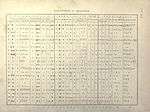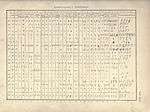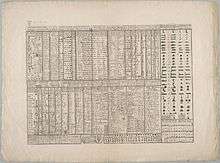Northwest Semitic languages
Northwest Semitic is a division of the Semitic languages comprising the indigenous languages of the Levant. It would have emerged from Common Semitic in the Early Bronze Age. It is first attested in proper names identified as Amorite in the Middle Bronze Age. The oldest coherent texts are in Ugaritic, dating to the Late Bronze Age, which by the time of the Bronze Age collapse are joined by Old Aramaic, and by the Iron Age by the Canaanite languages (Phoenician and Hebrew).[2]
| Northwest Semitic | |
|---|---|
| Levantine | |
| Geographic distribution | concentrated in the Middle East |
| Linguistic classification | Afro-Asiatic
|
| Subdivisions | |
| Glottolog | nort3165[1] |
The term was coined by Carl Brockelmann in 1908,[3] who separated Fritz Hommel's 1883 classification of West Semitic languages[3] into Northwest (Canaanite and Aramaic) and Southwest (Arabic and Abyssinian).[4]
Brockelmann's Canaanite sub-group includes Ugaritic, Phoenician and Hebrew. Some scholars would now separate Ugaritic as a separate branch of Northwest Semitic alongside Canaanite.
Central Semitic is a proposed intermediate group comprising Northwest Semitic and Arabic. Central Semitic is either a subgroup of West Semitic or a top-level division of Semitic alongside East Semitic and South Semitic.[5] SIL Ethnologue in its system of classification (of living languages only) eliminates Northwest Semitic entirely by joining Canaanite and Arabic in a "South-Central" group which together with Aramaic forms Central Semitic.[6] The Deir Alla Inscription and Samalian have been identified as language varieties falling outside Aramaic proper but with some similarities to it, possibly in an "Aramoid" or "Syrian" subgroup.[7][8]
It is clear that Taymanitic script expressed a distinct linguistic variety that is not Arabic and not closely related to Hismaic or Safaitic, while it can tentatively be suggested that it was more closely related to Northwest Semitic.[9]
Historical development



The time period for the split of Northwest Semitic from Proto-Semitic or from other Semitic groups is uncertain. The first attestation of a Northwest Semitic language is of Ugaritic in the 14th century BC.
During the early 1st millennium, the Phoenician language was spread throughout the Mediterranean by Phoenician colonists, most notably to Carthage in today's Tunisia. The Phoenician alphabet is of fundamental importance in human history as the source and ancestor of the Greek alphabet, the later Latin alphabet, the Aramaic (Square Hebrew), Syriac, and Arabic writing systems, Germanic runes, and ultimately Cyrillic.
By the 6th century BC, the use of Aramaic spread throughout the Northwest Semitic region (see Imperial Aramaic), largely driving the other Northwest Semitic languages to extinction. The ancient Judaeans adopted Aramaic for daily use, and parts of the Tanakh are written in it. Hebrew was preserved, however, as a Jewish liturgical language and language of scholarship, and resurrected in the 19th century, with modern adaptations, to become the Modern Hebrew language of the State of Israel.
After the Muslim conquests of the 7th century, Arabic began to gradually replace Aramaic throughout the region. Aramaic survives today as the liturgical language of the Syriac Christian Church, and is spoken in modern dialects by small and endangered populations scattered throughout the Middle East. There is also an Aramaic substratum in Levantine Arabic.
Sound changes
Phonologically, Ugaritic lost the sound *ṣ́, replacing it with /t͡s/ (ṣ) (the same shift occurred in Canaanite and Akkadian). That this same sound became /ʕ/ in Aramaic (although in Ancient Aramaic, it was written with qoph), suggests that Ugaritic is not the parent language of the group. An example of this sound shift can be seen in the word for earth: Ugaritic /ʔart͡s/ (’arṣ), Punic /ʔart͡s/ (’arṣ), Hebrew /ʔɛrɛt͡s/ (’ereṣ) and Aramaic /ʔarʕaː/ (’ar‘ā’).
The vowel shift from *aː to /oː/ distinguishes Canaanite from Ugaritic. Also, in the Canaanite group, the series of Semitic interdental fricatives become sibilants: *ð (ḏ), *θ (ṯ) and *θ̣ (ṱ) became /z/, /ʃ/ (š) and /sˤ/ (ṣ) respectively. The effect of this sound shift can be seen by comparing the following words:
| shift | Ugaritic | Aramaic | Biblical Hebrew | translation |
|---|---|---|---|---|
| *ð (ḏ)→/z/ | 𐎏𐎅𐎁 ḏhb |
דהב /dəhab/ (dəhaḇ) |
זהב /zaˈhab/ zahab |
gold |
| *θ (ṯ)→/ʃ/ (š) | 𐎘𐎍𐎘 ṯlṯ |
תלת /təlaːt/ (təlāṯ) |
שלוש/שלש /ʃaˈloʃ/ šaloš |
three |
| *θ̣ (ṱ)→/sˤ/ (ṣ) | 𐎉𐎆 ṱw |
טור /tˤuːr/ (ṭûr) |
צור /sˤur/ çur (ṣur) |
mountain (Aramaic) or cliff (Hebrew) |
Notes
- Hammarström, Harald; Forkel, Robert; Haspelmath, Martin, eds. (2017). "Northwest Semitic". Glottolog 3.0. Jena, Germany: Max Planck Institute for the Science of Human History.
- Aaron D. Rubin (2008). "The subgrouping of the Semitic languages". Language and Linguistics Compass. 2 (1): 61–84. doi:10.1111/j.1749-818x.2007.00044.x.
- The Semitic Languages: An International Handbook, Chapter V, page 425
- Kurzgefasste vergleichende Grammatik der semitischen Sprachen, Elemente der Laut- und Formenlehre (1908), quote "Das Westsemitische gliedert sich in zwei Hauptgruppen, das Nord- und das Südwestsemitische... Das Nordwestsemitische umfaßt das Kanaanäische und das Aramäische...Das Südwest semitische umfaßt das Arabische und Abessinische."
- Linguist List Central Semitic composite tree (with Aramaic and Canaanite grouped together in Northwest Semitic, and Arabic and Old South Arabian as sisters) Archived 2009-10-14 at the Wayback Machine
Linguist List bibliography of sources for composite tree Archived 2011-07-23 at the Wayback Machine
Rubin, Aaron D. 2007. The Subgrouping of the Semitic Languages, Language and Linguistics Compass, vol. 1.
Huehnergard, John. 2004. "Afro-Asiatic," The Cambridge Encyclopedia of the World's Ancient Languages (Cambridge, pp. 138-159).
Faber, Alice. 1997. "Genetic Subgrouping of the Semitic Languages," The Semitic Languages (Routledge, pp. 3-15)
Huehnergard, John. 1991. "Remarks on the Classification of the Northwest Semitic Languages," The Balaam Text from Deir 'Alla Re-evaluated (Brill, pp. 282-293).
Huehnergard, John. 1992. "Languages of the Ancient Near East," The Anchor Bible Dictionary, Volume 4, pp. 155-170.
Voigt, Rainer M. 1987. "The Classification of Central Semitic," Journal of Semitic Studies 32:1-19.
Goldenberg, Gideon. 1977. "The Semitic Languages of Ethiopia and Their Classification," Bulletin of the School of Oriental and African Studies 40:461-507.
Ethnologue Central Semitic entry (with Arabic and Canaanite grouped together against Aramaic)
The Ethnologue classification is based on Hetzron, Robert. 1987. "Semitic Languages," The World's Major Languages (Oxford, pp. 654-663).
The older grouping of Arabic with South Semitic was "based on cultural and geographical principles", not on principles of empirical historical linguistics (Faber, 1997, pg. 5). "However, more recently, [Arabic] has been grouped instead with Canaanite and Aramaic, under the rubric Central Semitic..., and this classification is certainly more appropriate for Ancient North Arabian" (Macdonald, M.C.A. 2004. "Ancient North Arabian," The Cambridge Encyclopedia of the World's Ancient Languages Cambridge, pp. 488-533. Quote on pg. 489). - "Semitic". Ethnologue. SIL International. Retrieved 2014-06-02.
- Huehnergard, John (1995). "What is Aramaic?". Aram (7): 282.
- Kogan, Leonid (2015). Geneological Classification of Semitic. de Gruyter. p. 601.
- Kootstra, Fokelien. "The Language of the Taymanitic Inscriptions and its Classification". Cite journal requires
|journal=(help)
Bibliography
- Blau, J. 1968. "Some Difficulties in the Reconstruction of 'Proto-Hebrew' and 'Proto-Canaanite'," in In Memoriam Paul Kahle. BZAW, 103. pp. 29–43
- Cross, F. M. 1965. “The Development of the Jewish Scripts,” in The Bible and the Ancient Near East: Essays in Honor of W. F. Albright, ed. G. E. Wright. New York. Reprinted 1965, Anchor Book Edition; New York, pp. 133–202.
- Cross, F. M. 1967. “The Origin and Early Evolution of the Alphabet,” EI 5: 8*-24*.
- Cross, F. M. 1982. “Alphabets and pots: Reflections on typological method in the dating of human artifacts,” MAARAV 3: 121-136.
- Cross, F. M. 1989. “The Invention and Development of the Alphabet,” in The Origins of Writing (ed. W. M. Senner; Lincoln: University of Nebraska), pp. 77–90.
- Cross, F. M. and Freedman, D. N. 1952. Early Hebrew Orthography: A Study of the Epigraphic Evidence New Haven: American Oriental Society.
- Daniels, Peter. 1996. The World’s Writing Systems. New York: Oxford.
- de Moor, Johannes C. 1988. "Narrative Poetry in Canaan," UF 20:149-171.
- Donner, H. and Rollig, W. 1962-64. Kanaanäische und aramäische Inschriften. 3 volumes. Wiesbaden. (5th ed.)
- Driver, G. R. 1976. Semitic Writing: From Pictograph to Alphabet. 3rd edition. London.
- Garbini, G. 1960. Il Semitico di nord-ovest. (And a critique by E.Y. Kutscher, JSS 10 (1965):21-51.)
- Garnier, Romain; Jacques, Guillaume (2012). "A neglected phonetic law: The assimilation of pretonic yod to a following coronal in North-West Semitic". Bulletin of the School of Oriental and African Studies. 75.1: 135–145. CiteSeerX 10.1.1.395.1033. doi:10.1017/s0041977x11001261.
- Garr, R. 1985. Dialect Geography of Syria-Palestine, 1000-586 B.C.E. Philadelphia: UPenn.
- Gelb, I. J. 1961. “The Early History of the West Semitic Peoples,” JCS 15:27-47.
- Gelb, I. J. 1963. A Study of Writing. 2nd edition. Chicago.
- Gibson, J. C. L. 1971-87. Textbook of Syrian Semitic Inscriptions. 3 Vols. Oxford: Clarendon.
- Ginsberg, H. L. 1970. “The Northwest Semitic Languages,” in The World History of the Jewish People, volume 1/2: Patriarches. Tel Aviv.
- Greenfield, J. C. 1969. “Amurrite, Ugaritic and Canaanite,” in Proceedings of the International Conference of Semitic Studies. Jerusalem. pp. 92–101.
- Halpern, B. 1987. “Dialect Distribution in Canaan and the Deir Alla Inscriptions,” in “Working with No Data”: Semitic and Egyptian Studies Presented to Thomas O. Lambdin. Ed. D. M. Golomb. Winona Lake, IN: Eisenbrauns. pp. 119–39.
- Harris, Z. 1939. Development of the Canaanite Dialects. AOS, 16. New Haven: AOS.
- Herr, Larry G. 1980. "The Formal Scripts of Iron Age Transjordan," BASOR 238:21-34.
- Hoftijzer, J. and Jongeling, K. 1995. Dictionary of the North-West Semitic inscriptions. 2 volumes. Leiden/New York: Brill. Not including Ugaritic.
- Huehnergard, J. 1990. "Remarks on the Classification of the Northwest Semitic Languages," in The Balaam Text from Deir Alla Re-evaluated: proceedings of the international symposium held at Leiden, 21–24 August 1989. pp. 282–93.
- Kaufman, S. A. 1988. “The Classification of North West Semitic Dialects of the Biblical Period and Some Implications Thereof,” in Proceedings of the Ninth World Congress of Jewish Studies (Panel Sessions: Hebrew and Aramaic Languages). Jerusalem: World Union of Jewish Studies. pp. 41–57.
- Moran, William L. 1961. “The Hebrew Language in its Northwest Semitic Background,” in The Bible and the Ancient Near East: Essays in Honor of W. F. Albright, ed. G. E. Wright. New York. Reprinted 1965, Anchor Book Edition; New York, pp. 59–84.
- Moran, William L. 1975. “The Syrian Scribe of the Jerusalem Amarna Letters,” in Unity and Diversity: Essays in the History, Literature, and Religion of the Ancient Near East (ed. H. Goedicke and J. J. M. Roberts; Baltimore/London: Johns Hopkins University Press) 146-166.
- Moscati, Sabatino, ed. 1969. An Introduction to the Comparative Grammar of the Semitic Languages: Phonology and Morphology. Porta Linguarum Orientalium, ns, 6. Wiesbaden: Otto Harrassowitz.
- Naveh, J. 1987. Early History of the Alphabet: An Introduction to West Semitic Epigraphy and Palaeography. 2nd edition. Jerusalem: Magnes. Especially sections on West Semitic.
- Parker, Simon B. 1997. Stories in Scripture and Inscriptions: Comparative Studies on Narratives in Northwest Semitic Inscriptions and the Hebrew Bible. Oxford: Oxford University Press.
- Rabin, C. 1971. "Semitic Languages," Encyclopaedia Judaica, volume 14, pp. 1149–57.
- Rabin, C. 1991. Semitic Languages (Jerusalem: Bialik). [in Hebrew]
- Rainey, A. F. 1986 “The Ancient Hebrew Prefix Conjugation in the Light of Amarnah Canaanite,” Hebrew Studies 27:1-19.
- Rainey, A. F. 1990. “The Prefix Conjugation Patterns of Early Northwest Semitic,” pp. 407–420 in Abusch, Tz., Huehnergard, J. and Steinkeller, P., eds. Lingering over Words, Studies in Ancient Near Eastern Literature in Honor of William L. Moran. Atlanta: Scholars.
- Renz, J. 1995. Handbuch der althebräischen Epigraphik. 3 volumes. Darmstadt.
- Vaughn, A. 1999 “Palaeographic Dating of Judean Seals and Its Significance for Biblical Research,” BASOR 313:43-64.